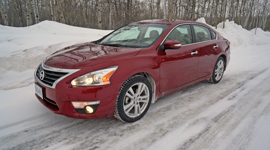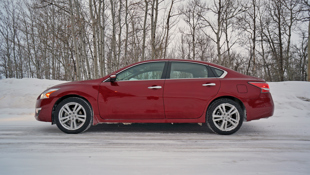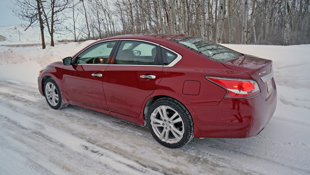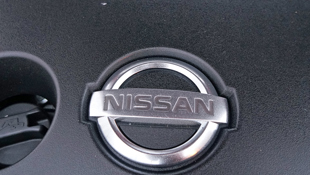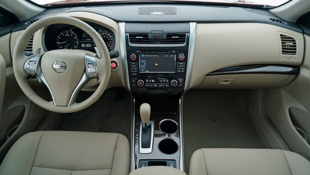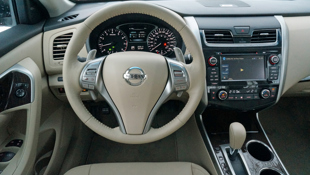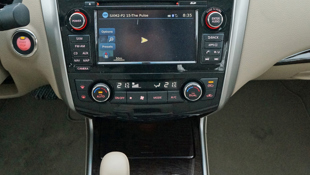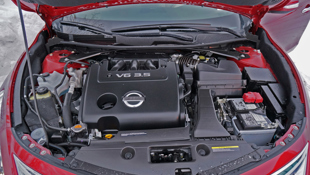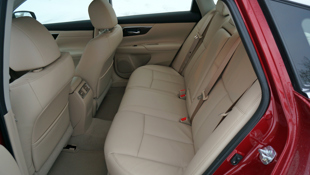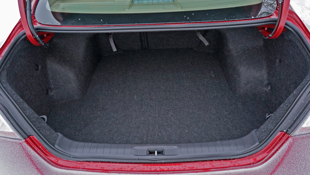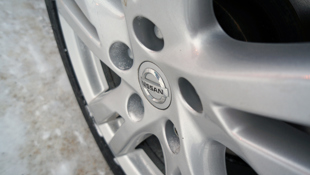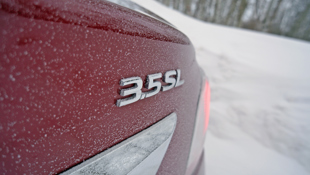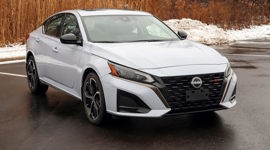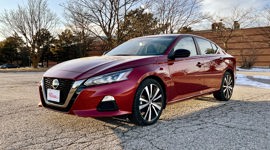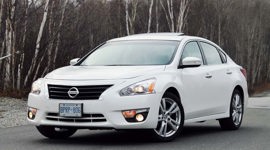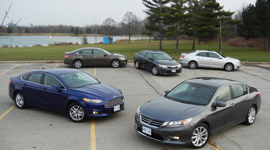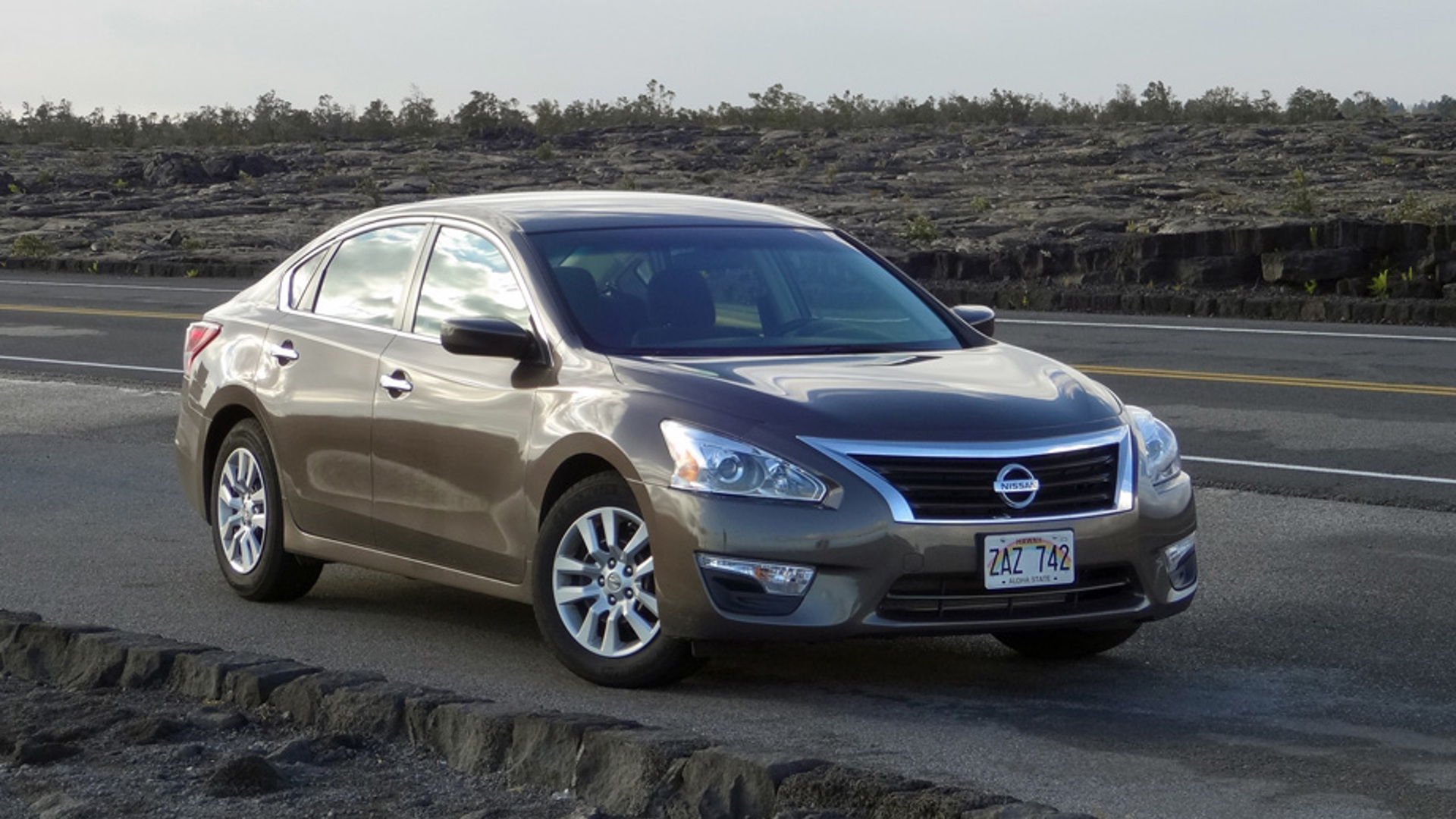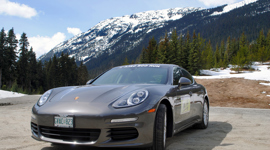My first Altima review was way back in 2001, and even though it wasn’t a class leader, I was smitten by Nissan’s ability to produce a small, sporty sedan that was efficient and responsive without trying too hard to stand out from the pack. It outperformed rival four-banger sedans and had value as another feather in its cap.
Times quickly changed, and Nissan responded to North America’s hunger for larger cars with more power with a complete redesign in 2003 and commensurate change in focus. Legroom and power were the new magic words, and this combination elevated the Altima’s image in its target market and Nissan has never looked back.
As with so many model lines from various manufacturers, the Altima has grown over the years and others have stepped in below to fill the gaps. The current Sentra is actually larger and more fuel efficient than that first Altima I reviewed.
2014 sees little in the way of changes since the Altima was completely redesigned last year. One new feature is the NissanConnect Apps system that allows integration of supported smartphone apps with the vehicle’s infotainment system. I downloaded the app in “demo” mode and found that the only apps available were Facebook and Google online search. This is the start of something good, but it should be noted that the aftermarket is ahead of the curve on this one: have a look at our review on the Pioneer Appradio 3.
One thing that hasn’t changed is Altima’s value proposition. Of course, in this cut-throat class, it has no choice. The base 2.5 model starts the bidding at $23,698 and includes a healthy dose of standard kit: a healthy four-banger/continuously-variable transmission combo, independent suspension and disc brakes all around, fog lights, dual exhaust tips, Bluetooth connectivity, push-button ignition, wheel-mounted cruise control, tilt/telescoping wheel, sunglass storage, map lights all around, four-speaker audio with Bluetooth streaming capability, and an econobox-like fuel consumption rating of 7.5 L/100 km city and 5.1 on the highway.
Throw in another $1,200 and you get the S: remote start and a rear-view monitor top the list of desirables, along with USB iPod interface, satellite radio, hands-free text messaging, and more.
As in other Nissan models, the SV manages to pull together most of the features people want in a well-priced package. The Altima SV is $26,198 and adds 17-inch alloys (16-inch steelies are standard on lesser models), heated front seats, a leather-wrapped wheel, power sunroof, dual-zone climate control, and some other goodies.
The 2.5SL furthers the luxury focus with leather upholstery and a premium audio system, choice of wood or metallic trim (both reasonable facsimiles of the real thing), and more for $28,898.
Our tester was the full-load 3.5 SL and is the only V6-powered model in the lineup. In addition to the 270-hp V6 humming under the hood, the $32,998 3.5 SL Tech gets 18-inch alloys. Interestingly, my spec sheet from Nissan shows the Tech package as a $1,100 factory option over the $31,898 3.5 SL, but Nissan.ca simply shows the 3.5 SL at $32,998 with the Tech package included.
Regardless of whether Nissan will let you order the car without the Tech package, that group includes navigation with a 7” touch display, nav controls on the wheel, blind-spot warning, lane-departure warning, and moving obstacle detection system.
Including a $135 charge for our tester’s Cayenne Red paint and $120 for carpeted floor mats (a bit inconsistent with our test subject’s value proposition), our tester tipped the scales at $33,253 plus freight and taxes.
Nissan has stopped offering the V6 in SV trim (available last year), which is unfortunate for power-hungry fools such as myself, but something tells me that not many customers will miss it. If they really want the power, they’ll pony up the extra three grand for the SL.
It’s not surprising that the V6 options are limited, as some competitors have canned the V6 option altogether. It’s becoming more common now to find a four-cylinder offering as well as a hybrid or diesel model, and in some cases a turbocharged four as the performance model. But Nissan is going a bit old-school here, and I’m thankful for it. After all, with EnerGuide consumption ratings of 9.4 L/100 km in the city and 6.2 on the highway, this V-6 consumes just marginally more fuel than the Hyundai/Kia 2.0L turbo-four.
For the record, there are still six-pots available in this class from Honda, Chrysler, Subaru, Toyota, and VW, but the selection is dwindling.
Rather than focusing on turbocharging or direct injection (or hybrids for that matter), Nissan is putting significant responsibility on its continuously-variable transmission (CVT) technology to get its fuel consumption down on all of its car and crossover models, so if you don’t like it, you’ll have to look elsewhere for your next ride. I, for one, am not a CVT fan and would consider it a deal-breaker for a personal vehicle. But that’s just me, and my wife and I have never owned a car with an automatic transmission, so take that for what it’s worth.
CVTs eschew fixed gear ratios in favour of a variable-diameter pulley and belt system that allows the car’s computers to continuously vary the ratio between engine speed and road speed for the most appropriate response under the conditions. The advantages, proponents say, are increases in both performance and fuel consumption as well as smoother, shiftless operation. The CVT’s downfall is a disconnectedness between right foot and engine response and droning (sustained high revs) under acceleration. This is particularly evident with less powerful four-cylinder engines that need to see higher revs to deliver power, and less so with powerful mills like this V-6 that can easily keep up with traffic while keeping the revs just above idle.
A lot of it has to do with software; engineers will have a mandate to minimize fuel consumption ratings and thus will program the transmission to keep revs low unless the right pedal is given a serious jab, giving the impression of a car that is less responsive than it should be.
Despite my general lack of enthusiasm for CVTs, Nissan is managing the use of this transmission in a way that can’t seem to figure out. The company is ahead of the curve with respect to responsiveness when a CVT gets between the driver’s right foot and the engine, and the result is a drive that isn’t spoiled, and is perhaps enhanced, by the CVT compared to a conventional automatic transmission. And the CVT’s flexibility and programmability allows the Nissan to achieve the consumption numbers worthy of bragging rights. It’s that balance that Nissan has achieved that makes it the exception with this type of transmission.
For the record, I achieved a fuel consumption of 8.7 L/100 km on the highway and 12.4 overall with a majority of city driving. Nowhere near the published ratings, but we’re used to that these days, especially in winter. And I did make use of the factory remote start more than once on frigid mornings which surely skewed the average consumption over this short one-week test drive.
The Altima’s blind-spot warning system does its job for the most part, but I’m one of those people who are picky about having my mirrors properly adjusted, and when they are, there is really no purpose for the blind-spot warning. What’s worse, I found the system to be overly sensitive and on a few occasions it spotted a car two lanes over rather than in the next lane. So there I was on a multi-lane roadway, having checked my mirrors and glanced over my shoulder signalling to change lanes and all of a sudden lights are flashing and beeps are sounding. I really don’t need a reason to second-guess myself after I’ve done the requisite checks, and found it to be an unnecessary distraction.
I did, however, appreciate the navigation system with its 7-inch touch display. It is attractive graphically and is very intuitive to use.
That goes for the Altima’s controls in general, too. Cruise, audio, Bluetooth, and trip computer functions are easily accessed on the steering wheel and there are sufficient hard buttons on the centre stack to do most functions without accessing the touch screen. In a day when too many vehicles have interfaces that distract more than they assist, the Altima’s system is refreshingly straightforward.
I’m not generally a big fan of light-coloured interiors, but the Altima’s beige leather is contrasts nicely with the darker upper dash, satin accents and wood-grain trim for a genuinely upscale appearance. The seats are cushy and comfortable for sure; just don’t expect torso-hugging support because it ain’t there.
Where I’d give the Altima’s interior a solid 8, the same can’t be said for its exterior looks. I complained about this last year and I’ll do it again. The Altima is just plain lumpy and the chrome grille and overdone lighting don’t do it any favours. Styling is highly subjective, yes, but I much prefer the cleaner and more modern designs of many of the Altima’s competitors: Fusion, Mazda6, Optima, Accord.
Trunk space is deceptively large; my 12-year-old daughter’s hockey bag and stick both fit in there without the need to fold down a seat. I never thought a sedan would be able to swallow all that gear.
Our tester wore Michelin Pilot Alpin winter tires, which are of the “high-performance” variety within the winter tire spectrum. While the firmer rubber compound and more performance-orient tread pattern preserved the car’s dry handling characteristics, they didn’t give the car enough of a bite in deep snow or on ice. If anything, they accentuated the Altima’s sensitive throttle tip-in. And when you’ve got a V-6 under the hood that spits out 251 lb-ft of torque, aggressive throttle response is not really appreciated in the winter. And because of the driving conditions, I didn’t get much of a chance to lay into this V-6, it was clear that reserve power was not in short supply.
The CVT did well with respect to avoiding the acceleration drone that so many CVT-equipped cars fall victim to. However, I did notice the same shudder at low speeds under light acceleration as I did with a Pathfinder last summer – a vehicle that shares the Altima’s engine/transmission combo.
Shift paddles are provided, but since the transmission doesn’t actually have gears that require shifting, it’s clear that this is just a ruse that might help Nissan sell some cars. But this is a flexible engine with a broad torque curve and we don’t need to be pretending it has gears just to make it feel sportier. Want more responsiveness? Just slide the Shift lever down from D into Ds and the transmission will dial up more engine revs and that will be it. No need for the gimmickry of shift paddles on this car.
The Altima is big on providing its occupants with a smooth, quiet ride. This is a luxury car in mainstream sedan duds, and it does its job very well. If you like the styling, it’s very easy to become accustomed to this fast, roomy people mover. Just don’t expect the sportiness on which the early Altima built its reputation.
| Model Tested | 2014 Nissan Altima 3.5 SL |
|---|---|
| Base Price | $31,898 |
| A/C Tax | $100 |
| Destination Fee | $1,575 |
| Price as Tested | $34,928 |
|
Optional Equipment
$1,355 ($1,100 - Technology Package, $135 – metallic paint, $120 – carpeted floor mats)
|
|
